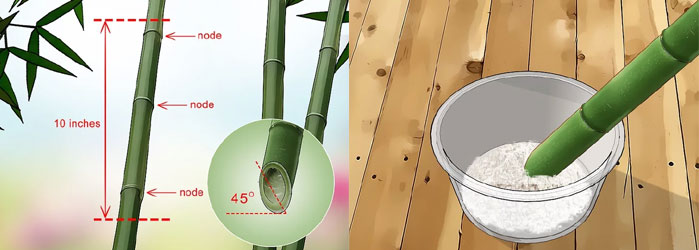Culm cuttings are highly suitable for thick-walled species with prominent nodal buds or branches with aerial roots. Pre-monsoon or early monsoon season is the ideal time for propagation through culm cuttings.
Mature culms (1–2-year-old) can be extracted from healthy, mature mother clumps, and splitting of culms should be avoided. The top portion can be discarded and the middle portion is ideal, the branches can be trimmed. Care should be taken not to injure the auxiliary beds on nodes while removing the leaves and side branches.

A culm cutting can have one, two, or three internodes with buds or branches. One or two nodded cuttings can be made using a hacksaw or a sharp knife. An opening can be made with 2 cm length and 1 cm width or two holes with approximately 7mm diameter in the center of the internodes. In the case of thin-walled species like Ochlandra travancorica, splitting of the culm at the cut surface has to be avoided. Cut at the half intermodal point on each side and transport the culms to the nursery site as quickly as possible, and care should be taken to prevent drying which can be achieved through wrapping the cut ends with moist gunny bags or covering in wet rice sacks.
Treatment with growth-regulating substances
The treatment with growth-regulating substances (GRS) like Naphthaleneacetic acid (NAA), and Indole 3-butyric acid (IBA) enhances rooting response in bamboo. For bamboos with hollow internode (e.g. Bambusa bambos), GRS solution can be poured into the cavity and for solid bamboos (e.g. Dendrocalamus strictus), dip method of treatment (the basal part is dipped in GRS solution overnight) is idle. For the cavity method of treatment in two-noded culm cutting, an opening (2 cm long and 1 cm wide) is made on the internode using a small sharp chisel, or two holes of 0.2-0.3 cm are made using a drill.
For most bamboo species, a 100 ppm solution of GRS is used. The volume of the solution required will depend on the size of the cavity. Generally, 50-100 ml is used for bamboos like Bambusa balcooa, B. bambos, Dendrocalamus brandisii, etc. For large diameter bamboos like D. giganteus about 250 to 500 ml of the solution will be required. The solution is poured into the internodal cavity and the hole is closed by wrapping and tying with a polythene strip, if it is a drill hole it can be easily sealed with plaster or any other adhesive tapes.
For the dip method of treatment, the basal part (covering the lower node) is immersed in the GRS solution in containers and left for about 12-15 hours, and then taken out for planting.
Preparation of growth-regulating substances
The GRS Solution is prepared by dissolving 1g Naphthaleneacetic acid (NAA) powder in 50 - 100 ml of 90 percent ethyl alcohol very slowly so as to avoid any coagulation. The solution is then made up to 1000 ml while adding the concentrated solution to water. The solution should be stirred while adding to water to avoid precipitation. This is the stock solution that can be stored for up to one week in dark containers. Solutions can be prepared at desired concentrations as follows
- 100 ppm → 100 ml stock solution + 900 ml water
- 200 ppm → 200 ml stock solution + 800 ml water
- 250 ppm → 250 ml stock solution + 750 ml water
- 500 ppm → 500 ml stock solution + 500 ml wate
The treated cuttings can be planted horizontally in nursery beds. One week before planting, the nursery beds are drenched with insecticides and fungicides to prevent the attack of termites and fungi. Culm cuttings are placed horizontally (the opening facing upwards) in the nursery bed, 15-30 cm apart. About 50-60 cuttings can be planted in a nursery bed of size 12 m x 1.2 m. Sprouting from the nodes takes place within a week. Initially, a cluster of sprouts develops and completes its height growth within one month. Natural thinning occurs by retaining two to five dominant sprouts. Slender roots develop within one month and rhizome development takes place within three to six months. At this stage, the rooted cuttings can be transferred to poly bags for macro-proliferation or planted in the field directly. If rooting occurs in two nodes they can be separated into two plants by cutting in the middle. The method is very successful with thick-walled species (rooting 60-95%) but not that encouraging in thin-walled species (0-40%).
